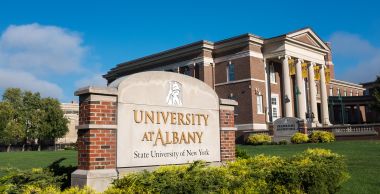Decision Making in Criminal Justice
Five School of Criminal Justice Researchers Published in Major Journal
 |
|
The School of Criminal Justice is housed in Draper Hall on the Downtown Campus. (Photo by Mark McCarty) |
ALBANY, N.Y. (Oct. 29, 2019) — Five UAlbany researchers are featured in the November edition of Criminology & Public Policy (CPP), which was released online Friday.
The journal issue focuses on the broad spectrum of decision making within the field of criminal justice — by offenders, within the court system, and by police units. The articles grew out of a School of Criminal Justice (SCJ) decision-making symposium last April focusing on recent advances in behavioral economics, which considers cultural, cognitive, psychological and economic factors to create “refined and more descriptively realistic models of decision making,” according Professor Greg Pogarsky.
“Most approaches to public safety rely on assumptions about the way people respond to risk and incentives,” Pogarsky said. “However, new research on behavioral economics shows that many of these old assumptions are misplaced. And with respect to decision making in the criminal justice process — e.g. citizens, police and judges — the stakes could not be higher. This research program looks for ways to leverage new decision-making insights to better understand criminal behavior, and contribute to more sensible and effective crime policies.”
Pogarsky, who also is SCJ’s associate dean, organized the symposium and is one of the authors in the November issue of CPP. His study, done with PhD candidate Shaina Herman, looks at behavioral economic theory to understand offender decision making and to inform innovative policies based on “prosocial nudges.”
“Better understanding how individuals make decisions about whether or not to offend in any given context tells us something fundamental about human behavior and provides invaluable insight for crime policy,” said SCJ Dean William Alex Pridemore. “Similarly, we must do more to learn how individual and group actors within the criminal justice system — like police, prosecutors and judges — make decisions, and recognize the implications of these decisions.”
Behavioral economics, Pogarsky says in his introduction to the journal, has the potential “to inform thinking about the nature of crime and societal responses to it. Principles of choice are essential to a range of criminological theories beyond rational choice. These include social control, social learning, and institutional anomie” — a lack of traditional social or ethical standards.
In addition to Pogarsky and Herman’s piece, “Nudging and the Choice Architecture of Offending Decisions,” three other articles in the November issue of CPP are by SCJ faculty and students.
- “Peers and Offender Decision-Making,” by then Assistant Professor Evelein Hoeben and Kyle Thomas, an assistant professor of sociology at the University of Colorado-Boulder, looks at the relationship between peer influence and rational choice in offender decision making.
- “The Promise of Behavioral Economics for Understanding Decision-Making in the Court,” by UAlbany Assistant Professor Theodore Wilson, looks at how courtroom decisions relating to sentencing may affect offender decision making, and how understanding the relationship could result in more effective policy.
- “Beyond False Positives: Typology of Police Shooting Errors,” by Paul L. Taylor, examines “the systematic nature of human error in the context of officer-involved shooting” in an effort to develop a framework for improved officer decision making. Taylor was a PhD candidate at SCJ when he wrote the piece; he is now an assistant professor at the University of Colorado-Denver.
“The application of insights from behavioral economics to crime and justice is becoming increasingly popular, and this issue of CPP highlights some of this research. It also highlights the strength of our UAlbany School of Criminal Justice in this emerging and innovative research area,” Dean Pridemore said. “Our school is home to the Laboratory for Decision Making in Crime and Justice, and the sophisticated work of several of our outstanding faculty and PhD students appears in this special issue. CPP is the leading journal in crime and justice policy and the excellent research and ideas in this special issue are sure to inspire further inquiry. I am proud of the unique contributions of our UAlbany School of Criminal Justice faculty and PhD students.”
![]() For more news, subscribe to UAlbany's RSS headline feeds
For more news, subscribe to UAlbany's RSS headline feeds
A comprehensive public research university, the University at Albany-SUNY offers more than 120 undergraduate majors and minors and 125 master's, doctoral and graduate certificate programs. UAlbany is a leader among all New York State colleges and universities in such diverse fields as atmospheric and environmental sciences, business, education, public health,health sciences, criminal justice, emergency preparedness, engineering and applied sciences, informatics, public administration, social welfare and sociology, taught by an extensive roster of faculty experts. It also offers expanded academic and research opportunities for students through an affiliation with Albany Law School. With a curriculum enhanced by 600 study-abroad opportunities, UAlbany launches great careers.


